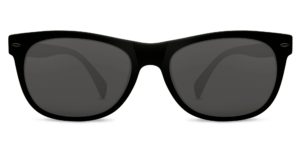Spectrum Expands For Color Blind Photographers!
by Arthur H. Bleich–

If you have normal color vision, here’s how you would see this garden scene.
If your prints look good to you but not to anyone else, you could be color blind. More than 14 million people in the U.S. and Canada are afflicted with some type of color vision deficiency ranging from mild to severe which makes it impossible for them to see colors that normal-sighted people see– and to tell different colors apart from one another.
With almost 60 million people seriously involved in photography, (excluding snapshooters) more than 2.5 million of them have color vision problems; you may be one of them or know someone who is. If you are a photographer or working in the creative arts, this condition can range from a minor annoyance to a big problem depending on how important color recognition is in your daily life.

The same scene as a person with Red/Green Deutanomoly color vision would see it.
These color-related eyesight anomalies are classified into several different types and affect 1-in-12 men (8% of the male population) and 1-in-200 women (0.5% of females)– and that adds up to more than 300-million people worldwide! Many are not aware of their condition; they simply accept what they see as the only colors in the spectrum.
Many famous people have been color blind. To name just a few: Pres. Bill Clinton, Sen. Marco Rubio, HRH Prince William, Jack Nicklaus, Sen. Bob Dole, Rod Stewart, Nicolas Cage, the late Paul Newman, and many others.
Color blindness is an inherited condition and there is no cure for it. About 99% of color blind people have the red/green type of which 75% is diagnosed as Deutanomoly and the other 25% Protanamoly. Are you color blind? You can find out in five minutes by taking a free test online (see Resources). If you have children, test them, too, because color blindness can affect their grades in school.

And heres what a person with Red/Green Protanomoly color vision would see.
Not much could be done about color blindness but recently a breakthrough occurred by chance. A company named EnChroma grew out of an incident at a Frisbee contest in 2003 when Dr. Don McPherson was wearing glasses he had developed to protect doctors’ eyes during laser surgery. He liked the way they enhanced colors.
One of his teammates–who was color blind–asked to try them. He marveled at all the colors he could see that he had never seen before, prompting McPherson to begin exploring the possibility that these glasses might help the color blind see colors better. Of course, refinements had to be made.
Enter Andy Schmeder, a math and electronics whizz. He joined McPherson and together they developed sophisticated computer models that simulated wavelengths of light and color vision deficiency. With the support of three government grants, EnChroma was born seven years later with co-founder Schmeder as its CEO.

And now seen with Tritanomaly, a rare form of color blindness and, so far, not correctable.
Most color blind people are not blind to color, but have trouble seeing certain colors and hues. Normal color vision is based on light entering the eye, and activating three photo-pigments sensitive to different parts of the visible spectrum (red, blue and green). In a normal eye, the green and red photo-pigments overlap. For the color blind, the overlap is more pronounced, causing distinct hues to become indistinguishable.
The absorption of light in the right ratios by the three photo-pigments in the eye is critical to color perception. McPherson and Schmeder created special eyeglasses that were able to optically remove small slices of light where the red and green cones overlapped the most. This resulted in a more accurate ratio of light entering the three photo-pigments so that a color blind person was able to enjoy more normal color vision.

EnChroma says their eye glasses are effective in 80% of Red/Green Deutanomaly or Protanomaly color blind cases.
EnChroma emphasizes that the glasses, are not a “cure” nor will they correct all types of color blindness, but says they are effective for about 80% of red-green color blind people. And while not providing 100% color vision, they enhance the vibrancy and saturation of certain colors and improve color discrimination, depth and detail perception.
It usually takes about 5-15 minutes for them to work after putting them on so to reduce that lag time and make them more convenient, (which would be especially useful to photographers) the company is developing a contact lens version.
For those whom the glasses work, the results can be emotionally overwhelming, as evidenced by videos shot of people trying them on for the first time; you can view these at EnChroma’s website. Both prescription and non-prescription versions are available and are priced from $270
RESOURCES
EnChroma’s Website: Take an eye test, see the videos and learn more.
Chromatic Vision Simulator: You can download an extraordinary, free, smartphone app that shows you what different types of color blindness look like in real-time. You can also upload your own images to see how how they would look to color blind people.
Visit the Red River Paper Website.
YOU ARE INVITED TO COMMENT ON THIS ARTICLE BELOW
Original Publication Date: April 27, 2017
Article Last updated: April 27, 2017
Comments are closed.
Categories
About Photographers
Announcements
Back to Basics
Books and Videos
Cards and Calendars
Commentary
Contests
Displaying Images
Editing for Print
Events
Favorite Photo Locations
Featured Software
Free Stuff
Handy Hardware
How-To-Do-It
Imaging
Inks and Papers
Marketing Images
Monitors
Odds and Ends
Photo Gear and Services
Photo History
Photography
Printer Reviews
Printing
Printing Project Ideas
Red River Paper
Red River Paper Pro
RRP Newsletters
RRP Products
Scanners and Scanning
Success on Paper
Techniques
Techniques
Tips and Tricks
Webinars
Words from the Web
Workshops and Exhibits
all
Archives
March, 2024
February, 2024
January, 2024
December, 2023
November, 2023
October, 2023
September, 2023
August, 2023
May, 2023
more archive dates
archive article list







